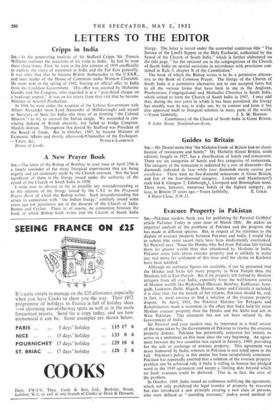Evacuee Property in Pakistan Sig,—Pakistan readers thank you for publishing
Sir Percival Griffiths' article Pakistan Today in your issue of March 28th. He makes an impartial analysts" of the problems of Pakistan and the progress she has made in different spheres. But, in respect of his reference to the dispute of evacuee property between Pakistan and India, I would like to submit that some recent facts have been inadvertently overlooked. Sir Percival says, "Since the Hindus who fled from Pakistan left behind them far greater wealth than that abandoned by Moslems in India, Pakistan cares little about evacuee property and is unlikely to make any real move for settlement of this issue until her claims on Kashmir have been satisfied."
Although no authentic figures are available, it can be presumed that the Hindus and Sikhs left more property in West Punjab than the Moslems left in East Punjab. But if the property left behind by Moslem refugees from all over India, especially from the well-known centres of Moslem wealth like Hyderabad (Deccan), Bombay, Kathiawar, Juna- gadh, Lucknow, Delhi, Aligarh, Meerut, Ajmer and Calcutta is included, it is clear that, for the benefit of her citizens, Pakistan should be, and, in fact, is, most anxious to find a solution of the evacuee property dispute. In April, 1951, the Pakistan Minister for Refugees and Rehabilitation made a statement to the effect that India held far more Moslem evacuee property than the Hindus and the Sikhs had left in West Pakistan. This statement has not yet been refuted by the Government of India.
Sir Percival and your readers may be interested in a brief review of the steps taken by the Government of Pakistan to resolve the evacuee property dispute. Pakistan has persistently reiterated her-anxiety to arrive at a settlement on this issue since the very beginning. An agree- ment between the two countries was signed in January, 1949, providing for the sale or exchange of evacuee property. This agreement was never honoured by India, whereas in Pakistan it. was acted upon to the full. Pakistan's policy in this matter has been scrupulously consistent. Pakistan has repeatedly asserted that a solution of the evacuee property problem can be achieved only if India is willing to honour her pledged word in the 1949 agreement and accept a limiting date beyond which no fresh evacuees could be declared.. That is, in fact, the crux of the problem.
In October, 1949, India issued an ordinance nullifying the agreement, which not only prohibited the legal transfer of property by evacuees but also introduced a new principle creating a new class of persons, who were defined as "intending evacuees," and, a novel method of seizing their property. The result was that in some parts of India Moslems who had no intention of migrating were declared "intending evacuees" en masse. This ordinance is still in force, and Moslems are still pushed into Pakistan as destitute.
Pakistan has always maintained that only by the restoration of the right of the owners to sell or exchange their property can this problem be effectively solved. India's views on the subject are not clear. At one time she insisted on exchange of property en bloc at governmental level; the Government which is left with more property .to pay the difference in cash. The two Governments are then supposed to distri- bute the property to the migrants on the basis of what they had left behind.
But is this scheme workable ? The proposal to let the owners sell or exchange their properties is the only solution to this knotty problem, and Pakistan has been and is prepared to honour her com-
mitments in this respect.—Yours faithfully, K. A. WAHEED. 22123 Jehangit Road, Karachi.



































 Previous page
Previous page